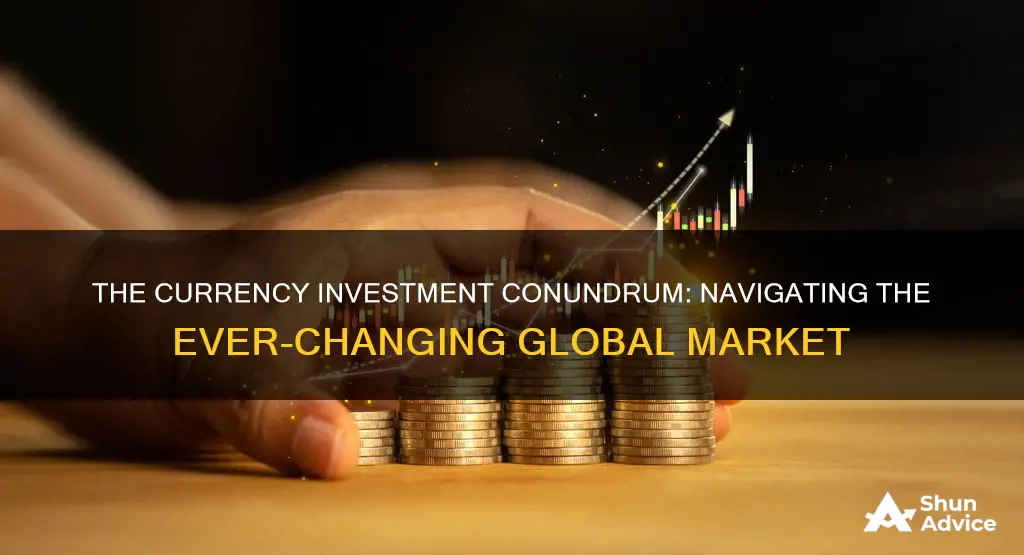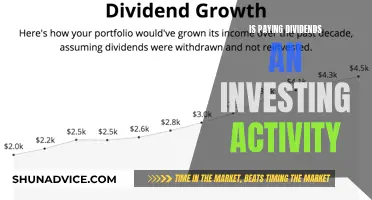
Investing in foreign currency can be a great way to diversify your portfolio. Foreign currency trading, or forex, is a little more complex than trading stocks or mutual funds. However, learning the basics can give you a solid foundation to build on if this is an asset class you're interested in exploring.
Forex trading always happens in pairs. For a transaction to be complete, one currency has to be exchanged for another. For example, you might buy U.S. dollars and sell British pounds or vice versa.
- United States Dollar (USD)
- European Euro (EUR)
- Swiss Franc (CHF)
- Japanese Yen (JPY)
- Swedish Krona (SEK)
- Norwegian Krone (NOK)
- British Pound Sterling (GBP)
- Australian Dollar (AUD)
- Singapore Dollar (SGD)
| Characteristics | Values |
|---|---|
| Currency Code | USD, EUR, CHF, JPY, SEK, NOK, GBP, AUD, SGD |
| Currency Name | United States Dollar, European Euro, Swiss Franc, Japanese Yen, Swedish Krona, Norwegian Krone, British Pound Sterling, Australian Dollar, Singapore Dollar |
| Exchange Rate | 1 USD = 0.92 EUR, 1 EUR = 1.06 USD, 1 CHF = 1.08 USD, 1 JPY = 0.0074 USD, 1 SEK = 0.093 USD, 1 NOK = 0.094 USD, 1 GBP = 1.20 USD, 1 AUD = 0.66 USD, 1 SGD = 0.74 USD |
| Investment Type | Long-term |
| Risks | Volatile markets, fluctuating exchange rates, high cost of hedging, illiquidity, political and economic instability |
| Benefits | Portfolio diversification, low transaction fees, convenience and accessibility, lower costs |
What You'll Learn

Stick to major, stable currencies
Currency investments can be risky, but they can also complement any balanced portfolio. One way to mitigate the risks is to stick to major, stable currencies.
Currencies like the US Dollar, Euro, Japanese Yen, and British Pound Sterling are considered stable and are among the most frequently traded currencies. They are also considered safer investment decisions.
The US Dollar, for example, is considered the world's reserve currency and, as of 2019, almost 90% of all Forex transactions were made in US Dollars. The Euro is the world's second reserve currency, and despite the complicated economic situation in some European countries, its value remains quite high and stable.
The Swiss Franc is another safe currency to invest in. Switzerland has a stable market economy, high GDP, a low unemployment rate, and an extremely advanced banking system.
The Japanese Yen is also a good choice for investment. Japan has maintained low inflation rates for extended periods, and the country has good trading relationships, contributing to the liquidity of the currency.
It is important to note that even these major, stable currencies are subject to fluctuations and volatility. However, by investing in these currencies, you can potentially minimize the risks associated with currency investments.
When Will Investments Rebound?
You may want to see also

Invest for the long term
Currency investments can be a great way to balance your portfolio, but they are not without risk. It's important to do your research and proceed with caution. Here are some tips for investing in currency for the long term:
- Consider using a broker: Trading currency, also known as forex trading, can be complex and requires a good understanding of the market. If you're new to forex trading or unsure about investing on your own, consider working with a broker. Choose a broker who is registered with the Securities and Exchange Commission and a member of the Financial Industry Regulatory Authority (FINRA).
- Stick to major, stable currencies: Focus on investing in well-established and stable currencies such as the British pound, US dollar, Japanese yen, and Swiss franc. Avoid investing in countries with unstable governments, a history of inflation, or high regulations.
- Buy an ETF or mutual fund: Investing in mutual funds and exchange-traded funds (ETFs) can provide diversification and reduce risk. These funds also do the macroeconomic research for you. For example, the Invesco DB G10 Currency Harvest Fund (DBV) tracks the Deutsche Bank G10 Currency Future Harvest Index, which is designed to capitalise on currencies with high-interest rates.
- Be aware of the risks: Currency trading is considered one of the most volatile markets, and values can fluctuate significantly based on various factors such as country and economic risks. It's important to educate yourself about these risks and carefully consider your investment decisions.
- Long-term investment strategies: If you're an experienced trader, a buy-and-hold strategy can be applied to currency trading. This involves understanding long-term economic trends and holding a currency for months or years to profit from favourable exchange rate changes. Additionally, consider the environmental factors that influence currency values, such as central bank policies, global sentiments, and trends in unemployment rates.
- Diversify your portfolio: To minimise risk, it's advisable to invest in a variety of different currencies rather than just one. This way, if one currency decreases in value, gains in another currency can help offset the losses.
Retirement Investment Strategies: Navigating Your 401(k) Options
You may want to see also

Consider using a broker
Using a broker is a great way to get started with currency investment. The foreign exchange market, or forex, is where the world's currencies are traded 24 hours a day, and brokers facilitate this trading.
Any investor can open a trading account with a forex broker, and there are many advantages to doing so. Firstly, brokers provide access to the forex market, which is not a physical entity but an electronic one. Secondly, brokers offer different platforms with varying required account minimums and transaction fees, allowing investors to choose a platform that suits their budget and goals. Thirdly, brokers handle fees, including commissions, access to expert advice, and withdrawal requests.
However, it is important to note that not all brokers are regulated, and traders should be cautious of unregulated firms. Reputable brokers will be registered with regulatory bodies such as the National Futures Association (NFA) in the United States. It is also crucial to review a broker's fee schedule, as some brokers may hide their fees within legal jargon on their websites.
When choosing a broker, consider the following:
- Regulatory compliance: Ensure the broker is registered with the relevant regulatory bodies, such as the NFA or the Commodity Futures Trading Commission (CFTC) in the United States.
- Account offerings: Compare features such as leverage and margin, commissions and spreads, initial deposit requirements, and ease of deposits and withdrawals.
- Currency pairs offered: Make sure the broker offers the currency pairs you are interested in trading.
- Customer support: Assess the availability and responsiveness of the broker's customer support.
- Trading platform: Evaluate the platform's technical and fundamental analysis tools, ease of use, and the presence of features like a "panic" button to close all open positions.
- Trading education and tools: Look for brokers that offer resources, tutorials, and analysis tools to help you make informed trading decisions.
Savings or Investment: Understanding the Difference When Buying an Asset
You may want to see also

Buy an ETF or mutual fund
If you're looking to invest in currency, you may want to consider buying an Exchange-Traded Fund (ETF) or mutual fund. These are both popular ways to diversify your portfolio.
Mutual Funds
Mutual funds are actively managed, meaning fund managers make decisions about how to allocate assets to beat the market. They can be riskier and tend to have higher fees and expense ratios due to their higher operations and trading costs. Mutual funds can only be purchased at the end of each trading day, based on a calculated price known as the net asset value. They also usually have a higher minimum investment requirement, with retail funds requiring a minimum investment of between $500 and $5,000.
ETFs
ETFs, on the other hand, are usually passively managed and track a market index or sector sub-index. They can be bought and sold just like stocks and are priced continuously by the market. ETFs can be cheaper to invest in, as you only need enough money to buy a single share. They also tend to be more tax-efficient than mutual funds. However, they may carry a higher risk due to their lack of diversification.
Currency ETFs
Currency ETFs track the performance of currency pairs consisting of domestic and foreign currencies. They can be used to speculate on the prices of currencies based on political and economic developments in a country. They are also used to diversify a portfolio or as a hedge against volatility in forex markets by importers and exporters.
Final Thoughts
Both ETFs and mutual funds are viable options for investing in currency. ETFs tend to be more flexible and cheaper, while mutual funds offer the expertise of fund managers. However, it's important to carefully consider the fees, risks, and potential returns associated with each option before making a decision.
Insurance: A Safe Investment Bet?
You may want to see also

Beware of levered currency investments
Leverage is a common feature of currency trading, or forex, and it can be a double-edged sword. Leverage is the use of borrowed money (or capital) to invest in a currency, and it can magnify the returns from favourable movements in a currency's exchange rate. However, it can also magnify losses.
The forex market is the largest in the world, with more than $5 trillion worth of currency exchanges occurring daily. Forex trading involves buying and selling the exchange rates of currencies, with the goal that the rate will move in the trader's favour.
- The Risks of Excessive Leverage: Leverage can amplify both profits and losses. While it can increase your potential gains, it can also lead to significant losses if the trade moves against you. It's important to understand the risks involved and to use risk management strategies, such as stop-loss orders, to control potential losses.
- Understanding Margin: Leverage involves borrowing a certain amount of money needed to invest in something. In forex, this is usually borrowed from a broker. The initial margin requirement is the percentage of the total transaction value that you are required to put up as collateral. For example, if you are required to deposit 1% of the total transaction value as margin and you intend to trade one standard lot of USD/CHF (equivalent to US$100,000), the margin required would be US$1,000. This gives you a margin-based leverage of 100:1.
- Calculating Real Leverage: Margin-based leverage doesn't necessarily reflect the true level of risk. To calculate the real leverage you are using, divide the total face value of your open positions by your trading capital. For example, if you have $10,000 in your account and you open a $100,000 position, you are trading with 10 times leverage.
- Choosing the Right Amount of Leverage: Traders should choose a level of leverage that they are comfortable with. If you are conservative or new to currency trading, you may prefer a lower level of leverage, such as 5:1 or 10:1. More experienced or risk-tolerant traders may be comfortable with higher levels of leverage, such as 50:1 or 100:1.
- The Impact of Volatility: Currency values can be influenced by many factors, and the process of determining the price of a currency is complex. Forex markets have historically been highly volatile, and currency values can fluctuate significantly in response to world events. Leverage can magnify these fluctuations, leading to larger gains or losses.
- The Importance of a Reputable Broker: It's important to identify a reputable forex broker to avoid scams. Brokers may limit the amount of leverage used initially with new traders, and they can also increase a trader's margin requirement or reduce the leverage ratio to manage their own risk.
- Daily Resets and Long-Term Impact: Leveraged exchange-traded funds (LETFs) use derivatives to amplify the returns of an underlying index or other assets. While they offer the potential for significant gains, they can also lead to significant losses. LETFs are typically used for day trading and are not suitable for long-term investments due to the daily reset mechanism, which can cause longer-term returns to diverge from simply compounding the underlying index's returns.
In summary, while leverage can be a powerful tool in currency trading, it's important to understand the risks involved. Forex trading is complex and can be highly volatile, so it's crucial to educate yourself and consider seeking advice from a qualified financial advisor before investing.
Invest in Coca-Cola: A Global Icon
You may want to see also
Frequently asked questions
There is no one "best" currency to invest in. A safer option is to invest in several different currencies, focusing on the most stable ones. These include the US Dollar (USD), the European Euro (EUR), the Swiss Franc (CHF), the Japanese Yen (JPY), the British Pound Sterling (GBP), the Australian Dollar (AUD), and the Singapore Dollar (SGD).
Foreign currency investing, or forex trading, involves buying the currency of one country while selling that of another. Forex trading always happens in pairs and is done through the foreign exchange market, which is managed by banks and other financial institutions.
Investing in foreign currency carries risks, including exchange-rate risk, transaction risk, and political risk. The foreign exchange market is also the most volatile market to trade in, after commodities. Additionally, currency investments can be illiquid, especially for currencies other than the major ones.







